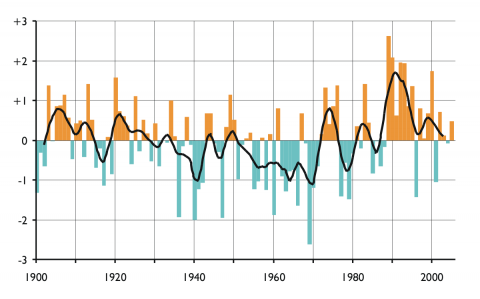Even though ENSO is known to be the main driver of skill at seasonal time-scales (Manzanas et al., 20141), other processes such as the Madden-Julian Oscillation, the Quasi-Biennial Oscillation, the Indian Ocean dipole, feedbacks between the ocean and the atmosphere and between the land and the atmosphere, and interactions between the stratosphere and lower layers of the atmosphere are expected to bring additional predictability.
In this regard, Scaife et al., 20142 have recently shown that the new UK Met Office seasonal forecast model Global Seasonal forecast system version 5 (GloSea5) was able to skillfully predict the wintertime North Atlantic Oscillation (NAO) index for the period 1993–2012, due a considerable increase in resolution. However, due to the limited length of the hindcast period used, this finding has provoked much controversy, since the estimates of skill measure based on small verification time series can have large departures from their expected value because of sampling errors (Kumar et al., 20093).
For instance, Shi et al., 20154 have shown that sampling uncertainty due to the length of the hindcast period is large. In particular, they found, using a combination of models from the DEMETER and ENSEMBLES projects, that the skill for forecasting the NAO during winter varies within the 40 year data sets with high levels of skill found for some subperiods. They demonstrated that while 20 year estimates of seasonal reliability can show evidence of overdispersive behavior, the 40 year estimates are more stable and show no evidence of overdispersion, indicating that a 20 year period may be insufficient for a robust estimation of overall predictive skill (which is in agreement with previous results from Muller et al., 20055).
- Manzanas, R., M. D. Frías, A. S. Cofiño, and J. M. Gutiérrez, 2014: Validation of 40 year multimodel seasonal precipitation forecasts: The role of ENSO on the global skill. Journal of Geophysical Research: Atmospheres, 119 (4), 1708–1719, doi:10.1002/2013JD020680, 2014.
- Scaife, A. A., et al., 2014: Skillful long-range prediction of European and North American winters. Geophysical Research Letters, 41 (7), 2514–2519, doi:10.1002/2014GL059637.
- Kumar, A., 2009: Finite samples and uncertainty estimates for skill measures for seasonal prediction. Monthly Weather Review, 137 (8), 2622–2631, doi:10.1175/2009MWR2814. 1.
- Shi, W., N. Schaller, D. MacLeod, T. N. Palmer, and A. Weisheimer, 2015: Impact of hindcast length on estimates of seasonal climate predictability. Geophysical Research Letters, 42 (5), 1554–1559, doi:10.1002/2014GL062829.
- Müller, W. A., C. Appenzeller, and C. Schär, 2015: Probabilistic seasonal prediction of the winter North Atlantic Oscillation and its impact on near surface temperature. Climate Dynamics, 24 (2), 213–226, doi:10.1007/s00382 004-0492-z.

